Classroom Relocation Project
A new development arises: The day after Alan and Saffron moved the students out of their old classroom and into the dining hall, the local primary school received food rations from the government. (Up until now, the school hadn’t received any rations for three months; hence, the building had been abandoned.) This made the duo’s original plan obsolete. Rodrigo calls a brainstorming meeting with the entire team to develop new solutions. The two challenges they face: fitting three classes into one building and making sure that the different classes don’t interfere with one another as they are in progress. After a few hours, the innovators come up with a new plan. The dormitory is a one-floor building with narrow dimensions. The group thinks they can take advantage of its length and section off three different portions for the classrooms using two wall dividers. TBI is making the design possible by providing great assistance with materials such as metal, welding work, plywood, drills, brooms, mops, and other equipment to the students.

The local school dormitory; mattresses line the walls. Photo credit Cheng-Wen Hsu
But before implementing their polished plan, the team must clean the dormitory which has collected dust and unwanted creatures in the time of its hiatus. With brooms, buckets, mops, water, and lots of cheer, the team assembles to clear the space. Once they arrive onsite, the usual swarms of primary school students clamor for their attention. After greeting all the lovely blue and pink uniforms, the group gets down to business. Two dozen old metal bed frames are in the way of their new classroom design. The innovation team breaks down the frames and pulls them out of the building one by one. The team shouts “chunga,” a Swahili word that means “Watch out!,” to the kids staring in excitement and curiosity along the way.

Rodrigo(middle) grabs a part of the bed frame. Photo credit Cheng-Wen Hsu

Giancarlos(middle) and Alan(interior) move a bed frame out of the building. Photo credit Cheng-Wen Hsu
After some time, the heavy metal fatigues the group causing progress to slow down. The school students sense this and begin walking into the dormitory building. One of the global innovation team, Addison, sees the opportunity to include the eager students in the project and passes small objects from the room to them. Suddenly, an assembly line of 5-14 years olds appears ripping bed frames, metal bars, and other materials out of the hands of the innovators.

The students join in! Photo credit Cheng-Wen Hsu

They take over the project! Photo credit Cheng-Wen Hsu
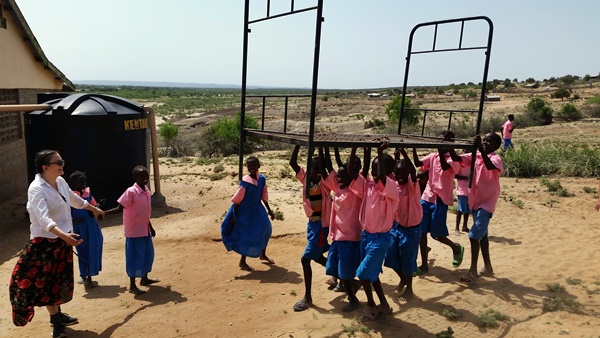
Saffron(left) looks astounded as the students show off their strength and enthusiasm. Photo credit Cheng-Wen Hsu

A special bond with the community
Next, the real work begins- cleaning the dormitory. The team wraps bandannas around their noses and mouths, grab brooms, and start dust busting.

Sweeping in a new design. Photo credit Cheng-Wen Hsu
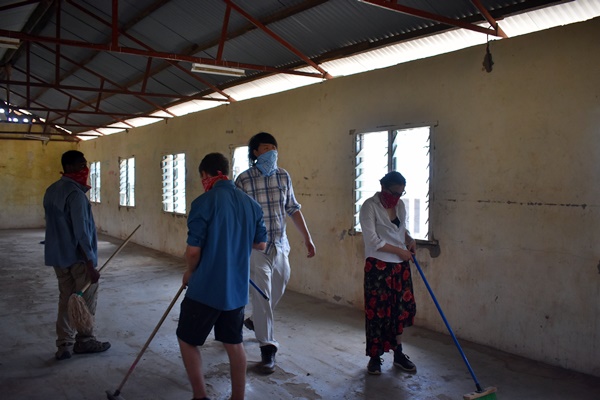
Julian(left to right), Jake, Alan, and Saffron get cleaning. Photo credit Cheng-Wen Hsu
After a day of hard labor, the team returns for lunch as Alan and Saffron plan out the next step of rehabilitation- building wall dividers for the classrooms.
Vaccine Freezer Storage
Nick and Brent have been steady at work. For their project, they have begun daily testing of the charcoal jugs that are used on TBI campus
The current temperature of the insulation jugs is at an average of 28℃. They need the jugs to reflect Beatrice’s, the head nurse, target goal of 8 ℃. To compensate for the difference, Brent and Nick are designing their theoretical system to have twice the capacity of water evaporation compared to the one in TBI. Their design also has charcoal covering a larger portion of the system to provide higher insulation for the natural refrigerator.
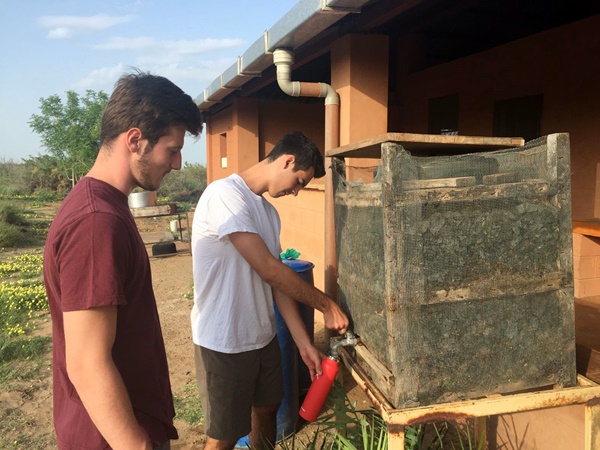
The team pours water from the charcoal insulated jug
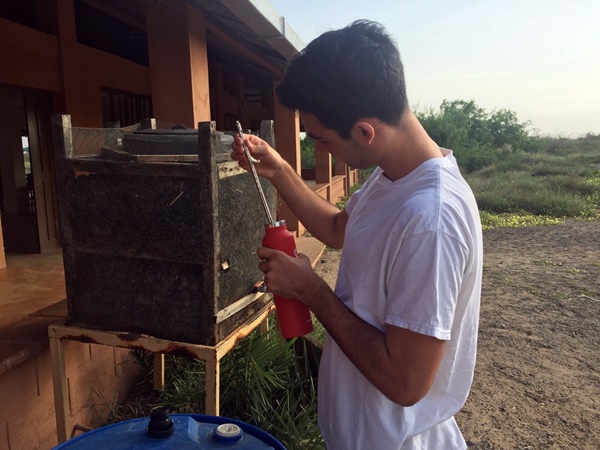
Brent tests the temperature of the water
From their test results, the jugs have reached an average of 26-28 degrees Celsius. This proves that the charcoal insulation is effective at maintaining temperature over time, but, (at least with the current set up available), does not provide a high decrease in temperature for the contents inside the jug. Because of their results, the group has decided that it is best for the clinic to reinvest in a new refrigerator or a cold room, (the cold room being the more sustainable option), in the long-term to provide the best capacity for their vaccines. The cold room, supplemented by a natural refrigerator, would offer low-energy storage with long term cooling capacity. Although this project will not be implemented during the time the students are here, the progress made in the research and testing has practical application in this clinic and others across the globe. Having this knowledge and experience will add to the students’ repertoire and to this program’s list of solutions for the community for the future.
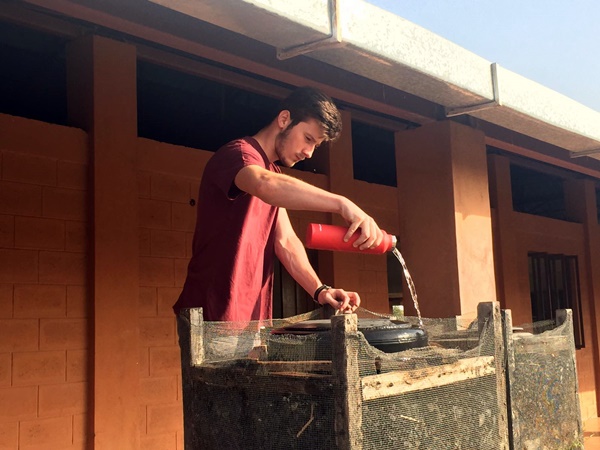
Progress
Garbage Collection & Bone Charcoal
Wen and Jake are making new connections in the community every day. This week, they meet with the teachers and environmental club at the local school about collecting trash in the community. The students seem eager to work with them to make an impact! Although this is a short term solution, the group is working to instill the cleanups as an ongoing activity in the community. They hope that Koriye, one of the young leaders in the community, and the church are will make the activity a biweekly to monthly occurrence in the town to promote waste management and pride within the community’s image.
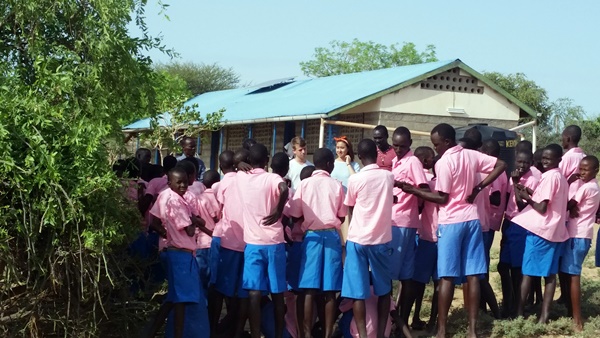
Jake and Wen speak to the environmental club at the local school
The church already started an initial trash pickup in the week and the Global Innovation team will be leading the next cleanup session soon! The team also made a trip to collect more bones and came back with two and half bags worth of bones. Their first experiments of bone burning were a success!
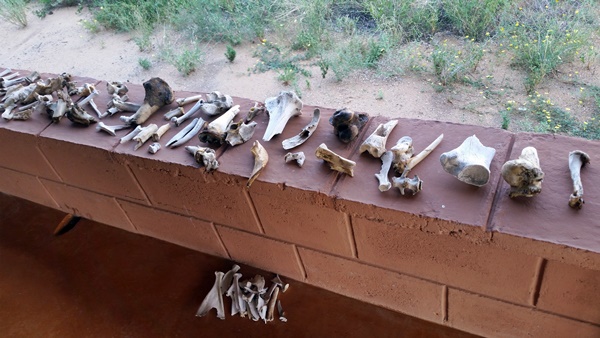
An abundance of test subjects

Their first sample of bone charcoal! Photo credit by Jacob Marlin

Jake crushes the bone charcoal for future testing. Photo credit Cheng-Wen Hsu
They plan to test the bone charcoal filtering capabilities in the surrounding area soon.
Wastewater Management
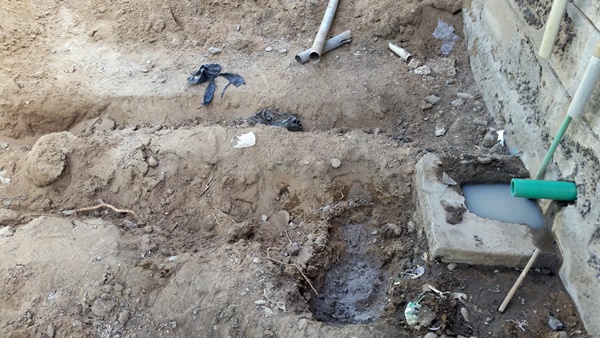
The current piping system of the town’s maternity clinic
Addison and Joe have pushed their project forward and finally broken ground for their wastewater system. Prior to the team’s arrival, a small bucket or basin was used in the sink and shower of the maternity clinic to capture wastewater. The staff would then have to manually dump the water outside to dispose of the waste. There are two buildings in the clinic with sinks that are no longer in use, but make perfect replacements for the maternity clinic facilities. In order to fix the sinks in the maternity clinic, the team is using scrap piping from other buildings.
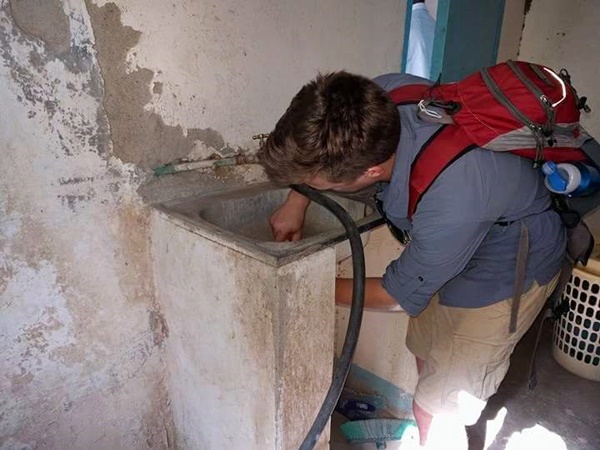
Addison and Joe reconnect the two sinks to the outside of the building, allowing for more efficient and easier use. Photo credit Joseph Kocaj
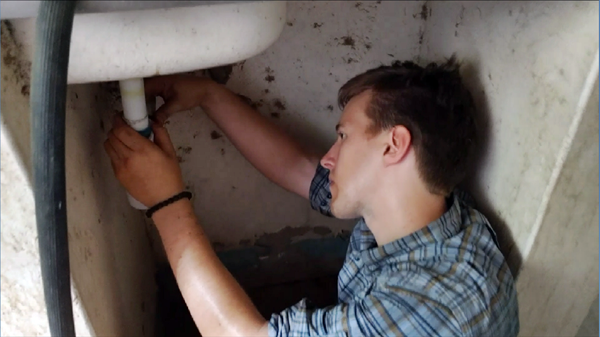
Addison uses a new pipe provided by the TBI facility to reconnect the sink. Photo credit Joseph Kocaj
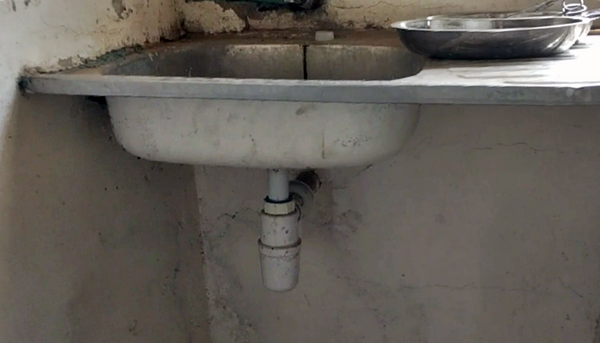
In the next room, the team uses pipes from another building to reconnect the sink. Photo credit Joseph Kocaj
With shovels in hand, the pair dig in the dirt to make way for their wastewater design.
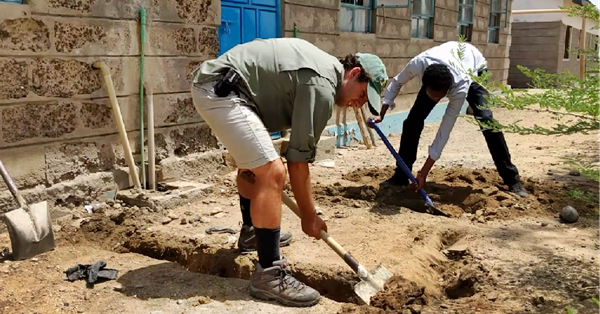
Joe(left) and Keena(right) break ground. Photo credit Addison Shogren
When they initially started, the group hit a snag. A large bush was in the way of their system. As they dug beneath it to discover if it could be moved, another snag appears. This bush has far extending roots over the entire area of the designated system. With quick thinking and grunt work, the team cuts through the bush and relocates it making room for the next phase. They will begin setting down barrels and pipes to implement their design.
Solar Panel Assessment and Rehabilitation
Giancarlos and Keena were anxious to meet with Madame Hilda, the Head Teacher of the school, to discuss the temporary exchange of solar parts between the school and the clinic. When they arrive at the school, they end up bumping into Shem, the Deputy Head Teacher. To their surprise, Shem mentions a few other systems at the school whose solar panels are malfunctioning. New locations are introduced to the group- a lab room, staff housing buildings, and a teacher conference room. At this point, the tag team has become well-versed in malfunctioning solar panel systems. In the staff buildings, bloated batteries sit in the corner. They have exploded rendering them useless- a common symptom of using a battery model not compatible with the heavy heat of Ileret. In the teacher’s conference room, the batteries are not blown but upon inspection, a new problem arises. The switches, which allow power to flow from the solar panels to the rest of the system, have broken and no power is able to flow. The team bypasses the switches with spare wire from TBI and continues their diagnosis. Once again, they find that the inverter, one of the main devices of the system has failed and will need replacement.
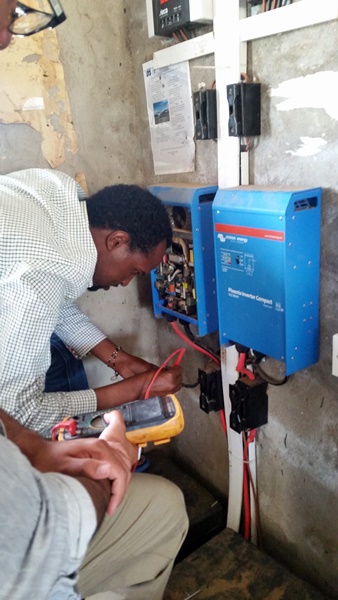
The team tests the system
The lab room is a dedicated space for students to work on computers that are going to be donated by another organization in the future. Being that most of the technology at the school is not functioning due to solar panel system failures, Giancarlos and Keena are invested in looking into this space. Here, they find a different brand of solar panel system with new hardware. The hardware provides more information and ability to interact with the system than the ones they’ve seen thus far. Along the walls of the room are outlets designated for charging laptops. At first, only the outlets along one wall are operational. But none of the lights or the outlets along the wall opposite gave a hint of operation. Giancarlos and Keena go through their routine of checking each individual device from the top-down to see where the break in communication between the technologies is occurring. They find that the break is at the charger/controller, also known as the regulator. Unlike most of the systems seen before, this charger/controller is still operational- a chance to return power to the building! The team changes the settings of the controller and reboots the system. After a few tries, Giancarlos places a charger in the wall outlet with fingers crossed. The LED on the charger glows brightly with triumph. Next, they hit the light switch- ON. The lights shined brightly in the room- the system has worked!
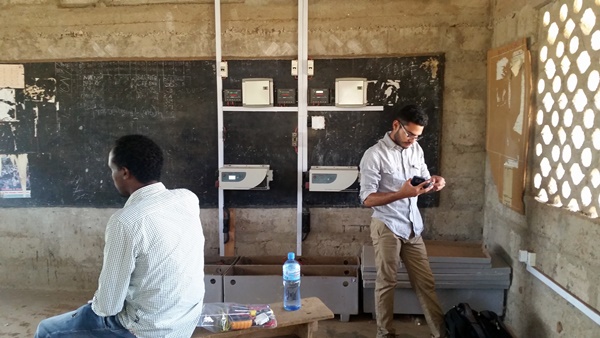
The pair reset the solar panel system with success!
Later, Giancarlos and Keena speak to Madame Hilda and tell her their plan of exchanging the regulator from the school and temporarily using it for the clinic. They also speak of their intention to fundraise money for the school after the program ends. They hope that with the funding, the different solar panel parts can be replaced. Madame Hilda accepts their proposal but plans to speak with Beatrice, the head nurse, first before going ahead with their plan.
The group hurried to the clinic to speak to Beatrice. When they arrived, Beatrice was out of the clinic providing outreach to the villages in the surrounding area. However, there was another task at hand.
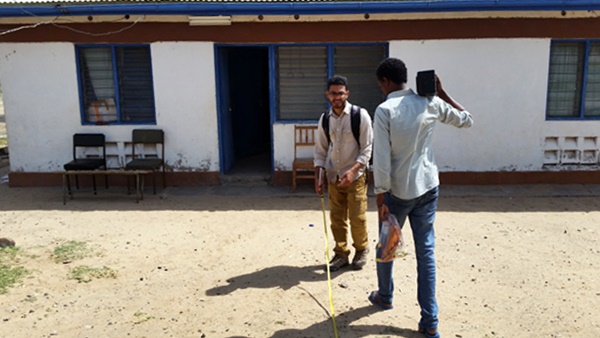
Giancarlos and Keena take measurements to prepare electrical wiring
There are three buildings which act as staff housing around the clinic. Two of the buildings are powered by solar panels already. But the one in which Beatrice lives is connected to the power system of the clinic, which is not operational due to the blown batteries. Currently her house is powered by a battery alone, which once drained, will not sustain the electricity needed. On one of their prior visits, Beatrice had proposed splitting power from a building with an operational solar panel system and placing it into hers. The group quickly assesses the load inside her building. The next day, they return with equipment and meet with Beatrice to conduct the power splitting.
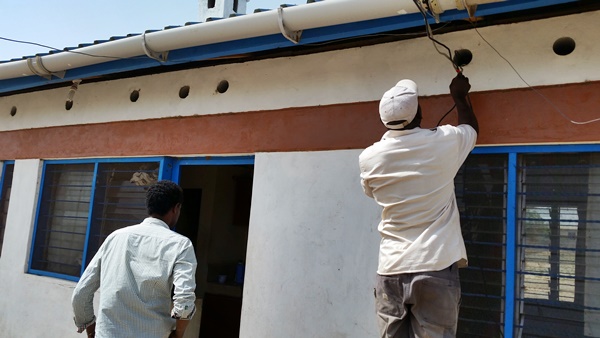
Mwang’ombe helps provide power to Beatrice’s house
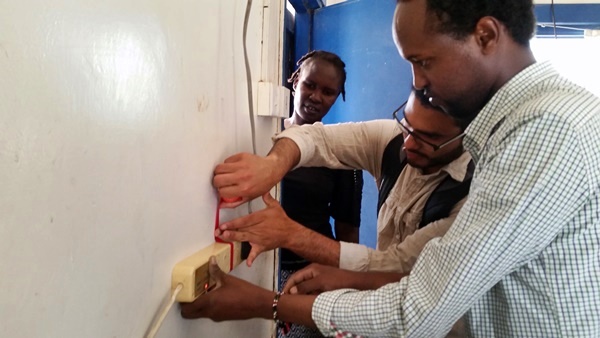
The pair add a temporary power strip to connect to the available electric power
Afterwards, they speak to Beatrice about the proposal to exchange devices from the school to the clinic. Beatrice accepts to meet with Madame Hilda. The team waits eagerly for the results of their meeting.
A Bat Problem
Another short term project made its way to the team’s table. The clinic has a food storage area where rations are donated for the kids of the community. The clinic gives these supplies out to families in need, but has a problem with contamination and protection of the rations. As one enters the food storage facility, the rasping sound of squeaking can be heard throughout the building. Bats have occupied the roof. They have broken through to some of the food and made the building hard to use for storage. The team decides to take on the bats with a little fire. With coal, matches, old tin cans, and some PVC pipe, the group gets smoking.
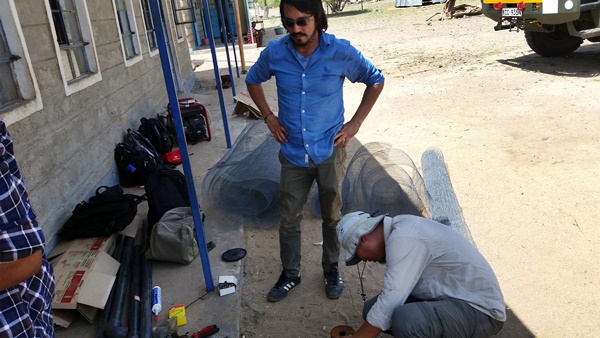
Rodrigo and Deming prepare equipment to combat the bats. Photo credit Keena Aliyaro
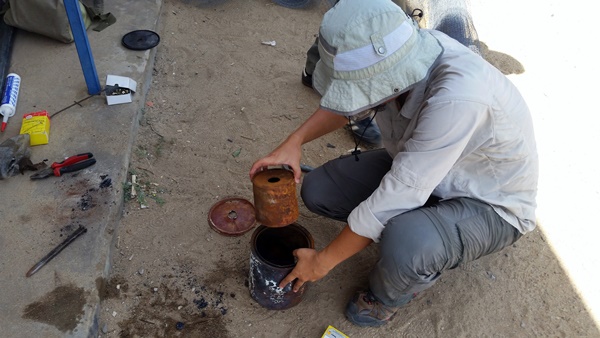
Deming prepares charcoal to be burned

The smoking apparatus. Photo credit Deming Yang
As the smoke blows upwards, bats jet out of the roof. Although the method is effective in clearing out some of the bats, others are persistent in staying and do not migrate outwards. The team will be back another day with more smoke and a new strategy to face the challenge.





